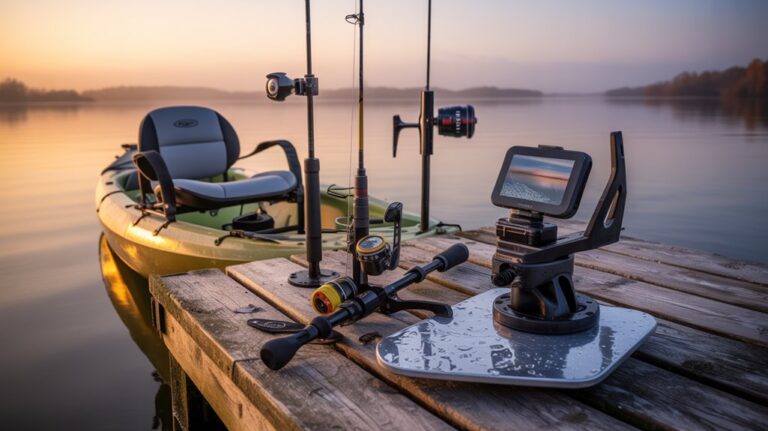Fishing from a kayak is an exciting way to access hard-to-reach waters. Start by choosing a stable kayak, ideally between 10 to 12 feet long, and make certain you've got a personal flotation device on. Dress appropriately for the weather and launch from safe, debris-free sites. Use basic paddling techniques to navigate, and consider drift fishing or trolling to cover more ground. Stealthy casting is key to avoiding scaring off fish. Target popular species like largemouth bass or northern pike for beginners. If you want to enhance your kayak fishing skills, there's plenty more to explore.
Tips for Beginners
When it comes to kayak fishing for beginners, safety should always come first and foremost. Always wear a personal flotation device (PFD) while you're on the water. This is essential for your safety.
Dress appropriately for the conditions—lightweight, moisture-wicking clothing in summer and layered clothing in winter will keep you comfortable. Start your journey in shallow water to practice paddling and get a feel for your kayak. This helps you build confidence before moving to larger bodies of water.
Maintain your balance by keeping your head aligned with the kayak's centerline, avoiding large movements that could disrupt your stability. As you get comfortable, you can start to maneuver your kayak around with your fishing rods and other fishing accessories.
Remember, basic kayak fishing requires patience, so take your time to learn the ropes. Use warm water conditions to your advantage; these are ideal for practice and will enhance your enjoyment of the sport.
Choosing the Right Kayak
Choosing the right kayak is vital for a successful fishing experience, and the perfect model can make all the difference. When you're looking for a kayak for fishing, prioritize a length between 10 to 12 feet for ideal stability and maneuverability.
Sit-on-top kayaks (SOT) are particularly advantageous, as they allow for easy entry and exit and provide better stability for standing while fishing.
Make certain the kayak has a weight capacity that accommodates both you and your gear to guarantee safe and effective performance on the water. Look for the best fishing kayak that includes features like multiple rod holders, ample storage space, and comfortable seating to enhance your fishing experience.
Testing different kayak models in person is vital; it helps you find one that fits your size, stature, and personal comfort preferences.
Taking the time to research and test kayaks will pay off when you're out on the water. Remember, the right kayak can greatly improve your enjoyment while fishing from a kayak, allowing you to focus on what really matters—landing that big catch!
Essential Gear and Safety
Fishing from a kayak requires not just skill but also the right gear and safety measures to guarantee a successful and enjoyable outing.
To make sure you're well-prepared, here's a list of crucial gear you shouldn't overlook:
- Personal Flotation Device (PFD): Always wear a properly fitting PFD, as recommended by the U.S. Coast Guard for safety while kayaking.
- First Aid Kit: Carry a well-stocked kit with bandages and antiseptic wipes to handle any minor accidents.
- Waterproof Bag or Dry Bag: Use these to protect your fishing gear and personal items from water exposure, keeping everything dry.
- Bilge Pump: Invest in a bilge pump to remove any water that may accumulate in your kayak, especially useful in case of capsizing.
Additionally, don't forget a signaling device, like a whistle or horn, to call for help if needed.
By equipping yourself with these crucial items, you'll enhance your safety and maximize your enjoyment while fishing from your kayak.
Always prioritize safety, and you'll have a great time on the water!
Launching and Navigation Techniques
With the right gear and safety measures in place, you're ready to hit the water. Start by choosing launch sites that provide easy access to the water, steering clear of rocky or debris-filled areas for a stable entry into your kayak.
Familiarize yourself with fundamental paddling techniques, like the Forward Stroke and Sweep Stroke, to enhance your maneuverability and speed.
Once you're on the water, use a paddle leash to secure your paddle while fishing. This prevents it from drifting away if you accidentally drop it.
Planning your kayak routes in advance is vital; consider circular patterns to reduce paddling fatigue while maximizing your fishing exploration.
Keep a close eye on environmental factors such as currents and weather conditions. Adjust your navigation strategies accordingly to maintain control and guarantee your safety.
As you paddle, remember that understanding how to control a fish once you've hooked one can lead to a successful outing.
Fishing Techniques and Strategies
A variety of effective fishing techniques can greatly enhance your success while kayak fishing. By mastering these strategies, you'll increase your chances of landing more fish.
Here are some key techniques to contemplate:
- Drift Fishing: Let your bait move naturally with the current, enticing bites from nearby fish.
- Trolling Methods: Cover larger water sections by paddling slowly while trailing lures behind your kayak.
- Stealthy Casting: Use low-profile casts and skipping techniques to avoid spooking skittish fish in shallow areas.
- Boat Positioning: Understand wind and current dynamics to improve your casting angles and catch rates.
Experiment with versatile lures like Texas rigged plastics or topwater baits to adapt to different fishing conditions.
These techniques will help you effectively target various species and maximize your time on the water.
Remember, the key to successful kayak fishing lies in your ability to adjust and refine your approach based on the conditions you encounter.
Popular Species to Target
Kayak fishing opens up a world of opportunities to target a variety of species, both in freshwater and saltwater environments.
If you're after freshwater species, consider focusing on largemouth bass and northern pike. Largemouth bass usually hang out in shallow waters near vegetation, making them perfect for kayak anglers using topwater lures or soft plastics.
Northern pike thrive in weedy areas, so spinnerbaits or jerkbaits work well, especially during early mornings or late evenings.
For saltwater species, red drum are a popular target. You'll often find them around structures like docks and jetties, where using live or cut bait can greatly increase your chances of landing one.
Fishing kayaks give you the flexibility to reach remote fishing spots, which can be ideal for catching brook trout and panfish in quiet lakes and rivers.
Conclusion
As you glide across the water in your kayak, think of yourself as a skilled angler steering through a vast sea of opportunities. Each cast is a brushstroke on the canvas of your adventure, blending patience and skill. With every ripple, you're not just fishing; you're weaving a tale of connection with nature. So grab your gear, embrace the journey, and let the thrill of the catch guide you. Your kayak awaits, ready to sail into new horizons of discovery.




